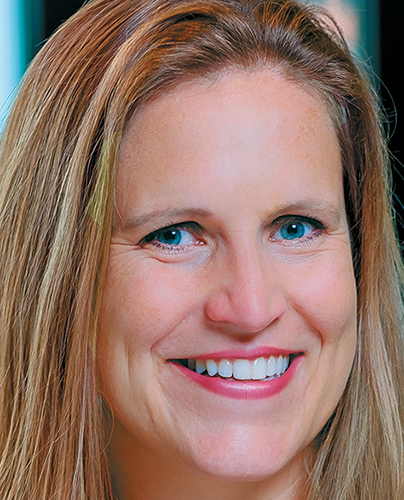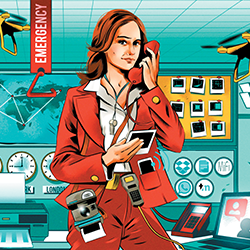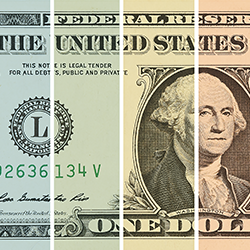|
exhibiting 101
 In-Booth Internet
Before you place your next internet-service order, make sure you have a thorough understanding of your wired and wireless options. By Betsy Earle
In our current age of touchscreen-based interactives, digital product literature, and immediate confirmation emails from lead-gathering systems, in-booth internet can seem as fundamental to trade show exhibiting as lanyards and branded giveaways. Given its importance, jargon-filled terminology, and the severity of the consequences should something go wrong, it's no wonder novice exhibit managers are often intimidated by the very idea of ordering internet services.
Show-provided internet basically falls into two main categories: wired and wireless. Each of these comes with advantages and disadvantages, and determining which service is right for your exhibit will depend on a number of factors, including required bandwidth, budget, types of internet-enabled devices, and timeline. To help you avoid any potential speed bumps on your way to the information superhighway, here is a primer on show-floor internet services. Wired Internet When it comes to reliability, speed, and bandwidth, wired internet service will outperform Wi-Fi in pretty much any venue. I always recommend that my clients choose hardwired internet if their budgets allow it. However, it is also far more costly, both in terms of the service itself and the labor required for its installation. This is because the necessary Ethernet cabling needs to be laid underneath the exhibit flooring by a trained technician during setup. As such, internet-service contractors require floor plans in advance (check the exhibitor services manual for deadlines) that show the desired location of the main internet drop – typically in a storage closet or counter – and where cabling should be accessible for tech elements needing an internet connection, e.g., computer terminals, on-site servers, etc. Keep in mind that altering these plans at the last minute can be costly and time consuming, so make every effort to lock in your internet needs early in the game. Procuring wired internet service will likely necessitate renting certain hardware, namely an internet hub, switch, router, or some combination of the three depending on the network infrastructure of the venue. This hardware allows you to access the venue's internet, connect multiple Ethernet cables, and set up your wireless network. An important side note: First-time exhibitors often think that connecting to Wi-Fi via an in-booth router exempts them from having to jump through the wired-internet hoops, i.e., needing to submit a floor plan or paying for a hardwire internet drop. They are mistaken, since that wireless signal is often facilitated by a wired connection in the booth. Diving deeper, wired internet can be ordered as either a dedicated or shared service. Exhibitors opting for shared service access the same data "pipeline," meaning the speed of their connections is determined, in part, by the degree to which other booths are taxing the venue's bandwidth. If dozens – if not hundreds – of exhibitors are simultaneously streaming videos and downloading or uploading content, it's possible that connection speeds will be affected. However, the difference may be negligible, depending on the venue. Costs for shared internet service vary greatly, but in my experience fees often run between $1,300 and $1,700 for the primary hookup, and additional connections can be purchased for much less, sometimes for as little as $150 each. Given its cost, this level of service is most suitable for exhibitors who need to stream high-resolution video content, download large files, and have multiple stations that require internet connections.
Although many exhibiting newbies cringe when they see the show-supplied internet service rates, ordering internet through the official provider comes with a significant bonus: You have an on-site resource if something goes wrong.
Exhibitors showcasing cloud-based software and/or products that require an internet connection to function may want to invest in dedicated internet service. This top-tier option features a dedicated IP address, resulting in a steadier bandwidth because the connection isn't shared with other exhibitors. Dedicated service is the most reliable – as well as the most expensive. A dedicated connection with a speed of 3 mbps can cost between $3,500 and $5,200 for the duration of the show, and I've seen 10 mbps go for up to $12,000. While these amounts are eye-popping to many of us, the peace of mind that having a dedicated internet connection can bring to an exhibit manager whose program lives and dies by bandwidth is priceless.Wireless Internet Now that we've covered the high end of the internet spectrum, let's examine the lower-cost option, i.e., wireless service. In addition to allowing exhibitors to avoid drafting specialized floor plans, renting hardware, and paying for elaborate Ethernet cabling installation, wireless service tends to be less expensive. The trade-offs, however, are decreased speed and, sometimes, fickle service. That being said, wireless service is generally improving, as convention centers across the country are investing heavily in upgrading their Wi-Fi capabilities. While the process certainly varies depending on the show and the venue, when you order wireless service through the show's internet provider, you'll frequently be given a unique login, a password, and a one-time-use code that will connect a single device to the convention center's Wi-Fi network. One wireless connection can cost between $1,000 and $1,500, with additional single-use codes for supplementary connections costing somewhere in the neighborhood of $150. In this scenario, if your exhibit's internet needs include connecting four Ipads and two Wi-Fi-enabled flatscreens, your internet invoice would be $1,750 (assuming an initial connection charge of $1,000), far less than the setup and access fees of wired service. Another perk of wireless service is that it can be easily amended on site should you need to connect an additional device at the last minute, although I still strongly recommend planning your internet needs well in advance to avoid wasting valuable time in the line in front of the exhibitor services desk. Some venues' internet providers have recently started offering exhibitors Wi-Fi hotspots to put in their booths as part of their wireless service. For example, at the 2018 National Association of Convenience Stores Show (NACS), $2,200 would get you an in-booth hotspot capable of providing 1.5 mbps internet access for up to 20 devices. Exhibitors needing additional bandwidth could rent a more powerful model that offered twice the speed and five times the connection points for $8,500. Regardless of how a venue's Wi-Fi signal makes it to your exhibit, wireless internet is, more often than not, a modest stream compared to the torrential speed of wired connections. While most convention centers' Wi-Fi can handle basic web browsing, loop internet-based video content, and load incoming lead information to your company's database, relying on it for more than that, e.g., streaming a media-rich, cloud-based presentation, is a gamble I suggest you avoid. Either allocate the funds for a more powerful wired connection or find an offline alternative, such as storing these large files on an external hard drive.
Altering your Ethernet-cabling floor plans at the last minute can be costly and time consuming, so make every effort to lock in your internet needs early in the game.
Finally, I should add that a number of convention centers also give exhibitors a "pay-as-you-go" option in which they can purchase wireless access directly on their mobile devices with a credit card, similar to how hotels and airports charge for Wi-Fi. Fees average around $75 per day for each device, although some venues will offer a multiday package for the duration of the show. This service's bandwidth is modest to say the least and is sufficient for little more than checking email and basic web browsing. But if your budget is tight or your exhibit is a simple tabletop display, this bare-bones service may be all you need.DIY Internet Thanks to a 2015 ruling by the Federal Communications Commission, convention centers can no longer prohibit exhibitors from sidestepping show-provided internet access and sourcing their own Wi-Fi. DIY options include using your smartphone as a hotspot or purchasing a mobile Wi-Fi device, the latter of which can often connect multiple devices and offer upload and download speeds comparable to many venues' official services. Still, I advise caution. Although many exhibiting newbies cringe when they see the show-supplied internet service rates, ordering internet through the official provider comes with one significant bonus: You have an on-site resource if something goes wrong. I've seen many exhibitors panic during setup when they realize their mobile hotspots can't get a signal from the show floor or make frantic – and often fruitless – phone calls to a customer-support line after their ad-hoc hookups fizzle out in the middle of an event. Think of it this way: The vast majority of exhibitors depend on third-party suppliers for multiple aspects of their programs, from exhibit design and fabrication to high-tech activations and promotional tchotchkes. When reliable internet access is more of a necessity than a luxury, why shortchange your exhibiting endeavors by going it alone in the hope of saving a few dollars? "It takes a village," as the saying goes, and that applies double to show-floor internet. E  Betsy Earle, CTSM
Betsy Earle, CTSMmanaging director and founder of Event Driven Solutions LLC. Earle obtained her MBA at the University of Miami and earned her Diamond-level CTSM designation in 2018. Exhibiting101@exhibitormagazine.com
|
|
|
||||||||||||||||||||||||||||
|
|
||||||||||||||||||||||||||||
|
TOPICS Measurement & Budgeting Planning & Execution Marketing & Promotion Events & Venues Personal & Career Exhibits & Experiences International Exhibiting Resources for Rookies Research & Resources |
MAGAZINE Subscribe Today! Renew Subscription Update Address Digital Downloads Newsletters Advertise |
FIND IT Exhibit & Display Producers Products & Services All Companies Get Listed |
EXHIBITORLIVE Sessions Certification Exhibit Hall Exhibit at the Show Registration |
ETRAK Sessions Certification F.A.Q. Registration |
EDUCATION WEEK Overview Sessions Hotel Registration |
CERTIFICATION The Program Steps to Certification Faculty and Staff Enroll in CTSM Submit Quiz Answers My CTSM |
AWARDS Sizzle Awards Exhibit Design Awards Portable/Modular Awards Corporate Event Awards Centers of Excellence |
NEWS Associations/Press Awards Company News International New Products People Shows & Events Venues & Destinations EXHIBITOR News |
||||||||||||||||||||
|
||||||||||||||||||||||||||||






